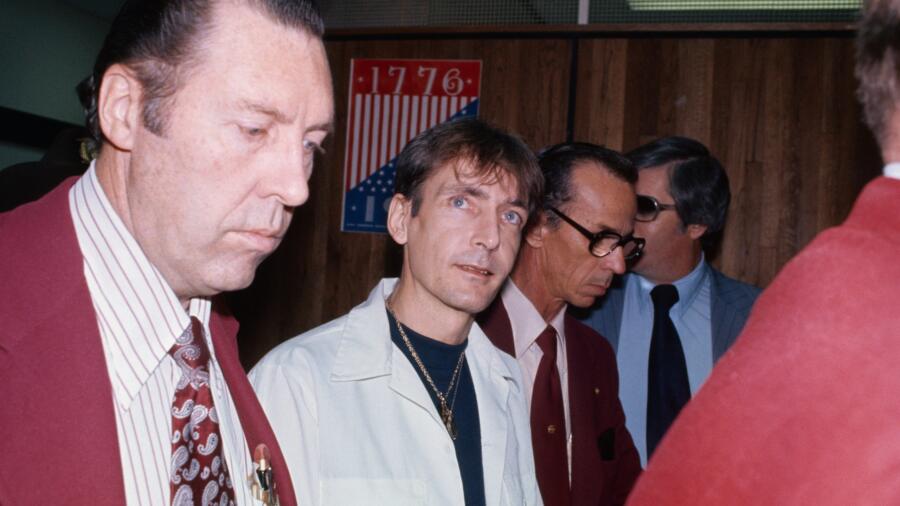“Let’s do it.”
— Gary Gilmore’s chilling final words before being executed by firing squad
In January 1977, Gary Gilmore became the first person executed in the United States after the Supreme Court reinstated the death penalty. But unlike most death row inmates, Gilmore didn’t fight his sentence—he demanded it. And his method of choice? A firing squad.
His defiant decision ignited a national debate, launched court battles, and ultimately turned him into a symbol of both controversy and control. Here’s how a two-time killer became a reluctant martyr for justice, and how his final words helped shape one of the world’s most iconic slogans.
A Troubled Beginning: The Making of a Murderer
“My father was the first person I ever wanted to murder.”
— Gary Gilmore, as quoted in Shot in the Heart by Mikal Gilmore
Born into a storm of violence and instability, Gary Gilmore’s childhood was marked by savage beatings, poverty, and rage. His father was an alcoholic conman who beat his sons with a razor strap, leaving deep physical and emotional scars.
Despite a high IQ and artistic talent, Gilmore gravitated toward crime. By 15, he was in reform school. By his 20s, he had multiple felony convictions and a growing rap sheet that would eventually land him behind bars for most of his adult life.
Released in 1976, Gilmore had a chance to rebuild. But within months, he would commit two brutal murders that would seal his fate.
Senseless Murders: A Coin Flip, a Motel Room, and No Motive
Gilmore’s post-prison life spiraled quickly. After reconnecting with family in Utah and falling in love with 19-year-old Nicole Barrett, a single mother, his deep-rooted violence resurfaced. When their relationship collapsed, so did he.
On July 19, 1976, Max Jensen, a 21-year-old BYU student, covered a night shift at a gas station—thanks to a lost coin toss. Gilmore walked in, forced him to lie on the floor, and shot him in the back of the head, execution-style.
“This one is for me. This one is for Nicole,” he said, firing a second shot.
The next night, he repeated the act—killing Bennie Bushnell, 25, at a motel. Both victims were compliant and unarmed. Both deaths were senseless.
When asked why, Gilmore offered only this:
“I don’t know. I don’t have a reason.”
The Trial and the Death Wish
Gilmore was caught within hours—his getaway botched when he accidentally shot himself in the hand. Blood led police directly to him.
His trial was swift. But what shocked the courtroom wasn’t just his cold demeanor—it was his refusal to fight the death sentence. He pleaded guilty, fired his lawyers, and refused appeals.
“I want the death penalty. I want to die. I do not want to spend my life in prison.”
When offered a choice between hanging and a firing squad, Gilmore chose bullets without hesitation.
“I’d rather be shot,” he smirked. “It’s a man’s way to go.”
A Legal Circus: The State vs. Gary Gilmore
Despite his wishes, others weren’t ready to let him die. His mother, the ACLU, and even President Jimmy Carter tried to intervene. A wave of anti-death penalty activists launched legal campaigns and appeals.
Gilmore fought them every step of the way. He attempted suicide multiple times, including a joint overdose with Nicole Barrett—an eerie reflection of Romeo and Juliet with a death row backdrop.
“I don’t want to live without her,” he wrote. “Let me go.”
The U.S. Supreme Court ultimately upheld his right to waive appeals, clearing the way for the execution.
The Execution: Firing Squad at Dawn
In the early morning of January 17, 1977, Gilmore was led into a cold, stark execution chamber at Utah State Prison.
Strapped to a chair, sandbags behind him, a white target pinned to his chest, he faced five anonymous riflemen. Four rifles were loaded with live rounds, one with a blank—to spare any shooter from knowing if their bullet had killed.
As the countdown began, Gilmore spoke his final words:
“Let’s do it.”
Four bullets tore into his heart. He was pronounced dead at 8:07 a.m.
Legacy: More Than Just a Killer
Gilmore’s execution didn’t just restart capital punishment—it became a cultural moment. His story inspired Norman Mailer’s Pulitzer Prize-winning book The Executioner’s Song, multiple documentaries, and films.
But perhaps the most unexpected legacy?
His final words inspired Nike’s iconic “Just Do It” slogan.
Advertising executive Dan Wieden cited Gilmore’s “Let’s do it” as the chilling spark that led to one of the most recognizable taglines in marketing history.
🧠 Frequently Asked Questions
Why did Gary Gilmore choose to be executed by firing squad?
He believed it was the most honorable method—“a man’s way to go.” He also wanted to avoid the prolonged appeals process and die on his own terms.
Was he the first person executed after the death penalty returned?
Yes. He was the first person executed in the U.S. after the 1976 reinstatement of capital punishment by the Supreme Court.
Did Gary Gilmore try to escape death row?
No. In fact, he fought against any appeals and attempted suicide when others tried to save him.
What were his last words?
“Let’s do it.” These words later inspired Nike’s slogan “Just Do It.”
What impact did his case have on American law?
Gilmore’s case reopened the death penalty era, sparking decades of legal, ethical, and cultural debate about state-sanctioned execution.

